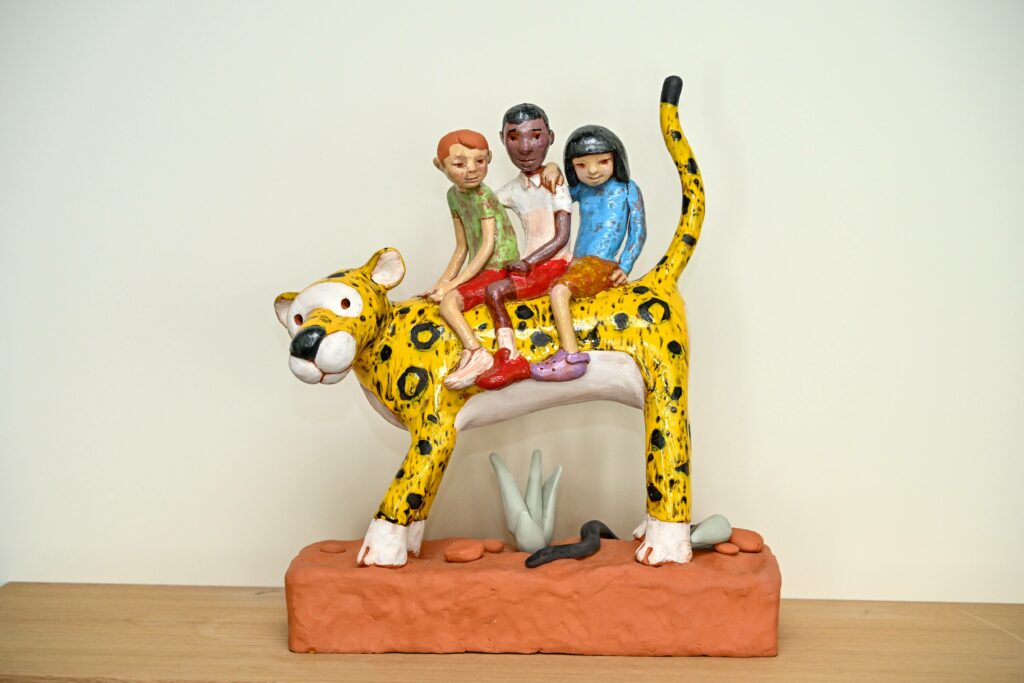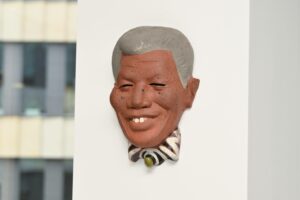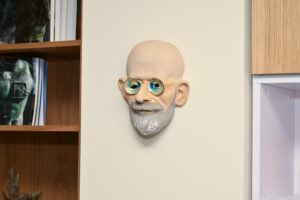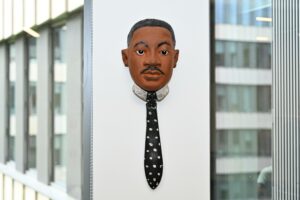22 Aug Turning the Office into a World of Imagination – Interview with Bruno Neuhamer
Turning the Office into a World of Imagination – Interview with Bruno Neuhamer

![]()
Upon entering the RiO Edu Centrum, one is captivated not only by the spaciousness and functionality of the interiors, but also by something rarely found in spaces with such a practical purpose: the warmth of color, the softness of form, and a clear impulse to unleash the imagination. This is the result of the work of Bruno Neuhamer, an artist who has for years combined the language of art with utility, creating spaces where aesthetics meet human needs.
Neuhamer is known for projects that not only decorate but also evoke emotions. His portfolio includes projects for children and young people, including collaborations with the Gajusz Foundation. At the RiO Edu Centrum, he tackled a unique challenge: he managed to strip an office space of its rigidity and transform it into an area that celebrates childhood imagination, where children of all ages can find their niche.
The conversation couldn’t avoid the topic of childhood, because it shapes each of us. We talked about years of carefreeness not only from the perspective of an artist, but also from the perspective of us adults, who increasingly recognize that our inner child is present throughout our lives. We talked about the creative process , the role of intuition, and why a thin layer of paint can completely transform the perception of a place, explains Bruno Neuhamer.
Why did you decide to participate in this project?
It was a combination of several reasons . For some time now, my projects have revolved around themes related to children. But what also attracted me to RiO was its multi-element nature – the ability to create an arrangement that is n’t just a single image, but a coherent narrative . Such projects allow for the development of thought and observation. It’s always an interesting experience.
Was it the ability to “decorate” the entire space—not just a fragment—that was most important?
Yes. I like being able to decide what elements appear in it and combine them with functional purpose. RiO was about more than just decoration—it was about creating a place where artistic language meets practicality.
What does the creative process look like?
I don’t start with a ready-made, clear concept. First, I gather inspiration—I reach into my “internal data bank,” things I have stored in my memory. I search through albums, returning to personal associations . I try to start from what I want to do, not from what “must be done.” The space could function without my intervention, but since someone invited me, my task was to find the problem and transform it to make it more welcoming and open.
Speaking of childhood, which has changed so much in recent decades (thankfully), how do you remember it? What was it like being a little boy?
When I was a child, the world wasn’t particularly geared towards the youngest. Children were often burdened by adult expectations. We were simply expected to grow up. There weren’t as many spaces, literature, or games created with us in mind. Today, it’s different – there’s a wide range of options and a greater acceptance of a child simply being a child. That’s good, but I notice that this world is often too literal .
Yes. We used to be able to take a stick and imagine it was a magic wand.
Now a child gets a ready-made, literal toy. I prefer to leave room for the imagination .
How do your childhood and your memories from that period translate into your work ? I draw from what I enjoyed as a child. It’s not a memory tucked away in a drawer—that part of me is still present, and I’m still in dialogue with it. In my time, childhood was a transitional stage. Today, I can—and want to—create something that appreciates and nurtures that childhood.
The RiO Education Center wasn’t an empty space that could be freely utilized. It was an office space. So how do you “strip” this office space of its rawness and , in a sense, its original purpose ?
First, you have to mentally remove everything that makes it an office. At RiO, I did this through color, composition, and a soft style . I also introduced elements of African art, which harmonize well with the foundation’s idea. I wanted this place to be therapeutic—to provide a sense of security and warmth, while still retaining its functionality.
 Do you adapt colors and forms to the age of the audience ?
Do you adapt colors and forms to the age of the audience ?
Yes, but intuitively. At RiO, we cater to a wide age group. I recall what I liked when I was a few years old and try to recreate it without unnecessary complications. Children don’t need complicated codes — it’s enough that the space is welcoming and leaves room for their own stories.
We’re talking about art, but also about memories. Does creating have a therapeutic dimension for you?
I think so. By creating, you can influence children’s memories. Positive images can become part of what they later recall as adults. RiO was about softening the harsh edges of everyday life and creating a space where one can feel safe.
It sounds like there’s something personal in it, too.
Perhaps . That archetypal image of relaxing on the beach , lying under an umbrella… it’s a return to a childhood state. Except today I know there’s no need to go back—it’s all within us all the time, we just need to allow ourselves to feel it.
 What was the significance of combining different experiences in this project?
What was the significance of combining different experiences in this project?
Enormous. At RiO, I combined color theory, composition, technical knowledge , and experience working on large formats. Nothing is left to chance there. And even though it’s just a thin layer of paint or clay, it can transform the perception of a space. The fact that the works don’t take away from functionality, but merely add a different dimension to the space, was crucial.
After completing the work, did you feel that the goal had been achieved ? Yes . The positive reactions of the people who use this space are the best proof. For me, that’s the greatest value – knowing that I managed to create a place that captures the imagination and emotions.



